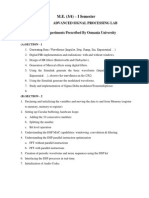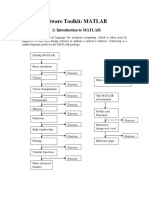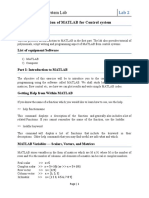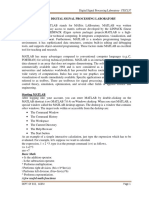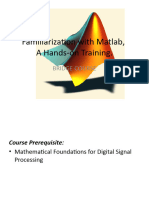0 ratings0% found this document useful (0 votes)
22 viewsMatlab Commands For Lab
wireless network
Uploaded by
41 Pratiksha PawarCopyright
© © All Rights Reserved
Available Formats
Download as PDF or read online on Scribd
0 ratings0% found this document useful (0 votes)
22 viewsMatlab Commands For Lab
wireless network
Uploaded by
41 Pratiksha PawarCopyright
© © All Rights Reserved
Available Formats
Download as PDF or read online on Scribd
You are on page 1/ 6
AA
A-2
INTRODUCTION
MATLAB is the powerful tool of modern scientific computations. The complex
engineering problems can be solved easily with the help of MATLAB programs,
Related and required commands can be drawn from respective MATLAB toolbox.
{ m-files corresponding to the MATLAB statement (concerned
MATLAB consists o!
algorithm). There are three types of windows concerned to MATLAB viz.
1. MATLAB command window.
2, MATLAB Editor / Debugger window.
3. MATLAB Figure window.
MATLAB command window : This window prompts >>, indicating that
L
it is ready for execution of MATLAB commands. Results are displayed in
command window. The command window can also be used to run small
programs.
2. MATLAB Editor / Debugger : Actual program is typed in this window
and saved the file with extension of mi.e., chetana.m (MATLAB command
abbreviations can not be used to save user files). All comments are written
after % (percentage) character and ; (semicolon) is used to end the
command.
MATLAB Figure window : After execution (Running) of MATLAB
program, the computed figure is displayed in MATLAB figure window.
EXECUTION PROCEDURE
+ Open MATLAB command window.
+ — Click on new m-file (MATLAB editor/debugger is opened with file name
untitled)
+ Type the program.
+ Comments must precede with % (percentage).
* Type (semicolon) at the end of each MATLAB command (optional).
A-3
+
No ‘end’ statement is required for MATLAB main program (if typed, user
gets warning message after running the program).
Click on ‘saveas’ and save the file with ‘filename.m’ in ‘work’ environment
of MATLAB software.
Click on ‘Tool’ and then click on ‘Run’ to execute the program (As per setting
ofoptions, user finds an arrow to the data to be inputed if program is correctly
typed otherwise error is displayed).
Enter the data samples (if not specified in program) in MATLAB command
window.
Enter all data samples within the SQUARE BRACKETS and a SPACE
between each sample.
‘After entering all the input data, the result is displayed in command window
or figure window (As per program).
Users are advised to follow the execution procedure before proceeding with
MATLAB programming.
M.
computation tim
far
ATLAB programs are compact, flexible and easy to execute except the
e for longer programs. As a author, users are advised to look the
ntasy of MATLAB programming.
LIST OF MATLAB COMMANDS
‘The following list of MATLAB commands are very useful for signal processing.
Use “help” or “lookfor” for more information about commands.
Command Description
Basic Commands.
abs (x) ‘Computes the absolute value of vector x.
angle (x) Computes the phase angle of vector x in radians.
axis (x) Sets the manual scaling value on plots.
break Stops the execution of loops.
elf Removes all the objects from current figure.
ceil(x) Rounds to the nearest integer value of x.
real (x) Takes the real part of each exponents of vector X-
imag (2) ‘Takes the imaginary part of each exponents of vector ©
conj (x) Complex conjugate of each components of x-
exp (p) Computes the exponential value.
sum (x) Sum of components of vector x.
force |
log (x)
1ogi0 (x)
sqrt (x)
disp (x)
end
error
format
grid
gtext
help
hold
input
inv
legend
length
linspace
load
lookfor
max
min
Nan
ones
pause
pi
plot
rand
randn
rem
return
save
size
Product of components of vector x.
Computes natural logarithm of x
Computes the logarithm of x with base 10,
Computes the squaroot of x. :
Displays the tex or z
Terminates the — onthe semen,
Displays an error message.
Displays the format of display (long or short),
Adds or deletes grid lines to or from the current plot.
Places the text on figure with the help of mouse,
Provides on line help of MATLAB commands.
Holds the current graph.
Request for the data to be supplied by user.
Evaluates inverse of matrix.
Inserts a legend on current figure.
Calculates the length of vector.
Generates linearly spaced vectors.
Obtain saved data from the disk.
Provides search through all help entries.
Determines largest element of vector.
Determines smallest element of vector.
Not-a-Number.
Generates a vector with element value 1.
Execution stops temporarily until any key is pressed.
Value of 2.
Generates 2-D plots.
Generates random numbers uniformly, distributed in the
interval 0 and 1.
Generates random numbers with zero mean and unity
variance. ’
Determines the reminder from matrix division.
Return to the key board.
Saves the variables on the disk.
dimension.
stem Plots the discrete values of sequence.
subplot Breaks the figure window into multiple planes for multiple
figure display.
title Write the heading on the top of current figure.
what Provides the directory listing of files.
which Locates the functions and files.
who Lists the current variables in the memory.
whos Lists the variables in memory, their sizes and nonzero
imaginary parts
xlabel Write the text below the x axis of plot.
ylabel Write the text vertically on y axis of plot.
zeros Generates the vector with element zero.
Convolution and correlation related commands
conv Computes convolution of two sequences.
decony Performs the operation of polynomial division.
xcorr Computes the correlation between two sequences,
DEFT / FFT related commands
freqz Computes the complex frequency response of digital
transfer function.
ats Computes the discrete fourier series.
rem Determines the reminder after division.
mod Computes the mod value.
dft Computes the N-point DFT of sequence x.
idft Computes the N-point inverse DFT of x.
ovrlpsav Computes the linear convolution of real time sequence
by overlap save method,
fft Implements radix-2 FFT algorithm.
ifft Implements radix-2 inverse FFT algorithm.
£f£tshift(x)| Rearrange the output of FFT so that the zero frequency
component is at the center of the spectrum.
Z-Transform related commands
zplane Displays poles and zeros in z plane.
roots Computes the roots of z polynomial.
————————
a
residue Determine the partial fraction of DT tr
expressed by ratio of z-polynomial ‘ansfer function
residuez Determine the partial fraction of DT transf:
expressed by the ratio of 2” polynomial sfer function
filter Implements the filter given by difference equati
ation.
impz Computes the impulse resi :
ponse coeffi igi
transfer funetion. setents of digital
peaen Calculates the zeros, poles and :
, gains of
function in even transfer
apatf Calculates the numerator and denominator coefficients
of transfer function.
Determines the equivalent second order representation
zp2so8
from given higher order pole/zero polynomial.
Filter related commands
—
putter Designs the digitaV/analog Butterworth filters.
puttord Selects the minimum order of the digital/analog
butterworth transfer function.
chebyl Designs the digitaVanalog ‘Type-I Chebyshev filters.
cheby2 Designs the digital/analog ‘Type-II Chebyshev filters.
chebiord Selects the minimum order of digital/analog Type-1
Chebyshev transfer function.
cheb2ord Selects the minimum order of the digitaVanalog Type-2
Chebyshev transfer function.
ellip Designs the digital/analog elliptic filter.
ellipord Selects the minimum order of digital/analog elliptic
transfer function.
freqs Computes the complex frequency response of analog
transfer function.
firl Designs lincar phase FIR filter.
fir2 Designs linear phase FIR filter with any magnitude.
bilinear This command converts an analog filter with zeros Z, poles
(2,P,K,Fs) P and gain Kin to digital filter with sampling frequency
Fs Hz.
bilinear This command converts an analog filter with numerator
(N,D,Fs) polynomial coefficients, denominator polynomial
coefficients and sampling frequency Fs.
boxcar (M) Generates M point rectangular window.
bartiet(m) | Generates M point bartlet window
hanning(m) | Generates M point hanning window.
hamming (M) Generates M point hamming window.
blackman(m)| Generates M point blackman window.
kaiser (Mm) Generates M point kaiser window.
kaiserord Calculates the filter order.
Additional Commands
Computes sine function of an array.
Determines sine values.
Calculates signum function.
sine
sin
sign
cos
Computes cosine values.
Rounds to nearest integer value.
Determines reflected (folded) sequence.
Computes number of floating point operation.
Converts number to string representation.
Generates sawtooth wave form.
Generates staircase wave form.
Computes discrete time wavelet transform.
Computes inverse discrete time wavelet transform.
Computer’ continuous time wavelet transform.
round
fliplr
flops
num2str
sawtooth
stairs
dwt
idwt
cwr
Note: Detailed explanation of each MATLAB command can be obtained by
help or lookfor commands.
You might also like
- Computational Aids in Aeroservoelastic Analysis Using MATLABNo ratings yetComputational Aids in Aeroservoelastic Analysis Using MATLAB175 pages
- Introduction To DSP Simulations in MATLAB PDFNo ratings yetIntroduction To DSP Simulations in MATLAB PDF36 pages
- Lecture Digital Image Processing 2017: Getting StartedNo ratings yetLecture Digital Image Processing 2017: Getting Started9 pages
- Introduction To MATLAB: Stefan Güttel October 15, 2020No ratings yetIntroduction To MATLAB: Stefan Güttel October 15, 202012 pages
- EE 105: MATLAB As An Engineer's Problem Solving ToolNo ratings yetEE 105: MATLAB As An Engineer's Problem Solving Tool3 pages
- Quick Introduction To Matlab: Basic Data AnalysisNo ratings yetQuick Introduction To Matlab: Basic Data Analysis10 pages
- Introduction To Matlab: by Kristian Sandberg, Department of Applied Mathematics, University of ColoradoNo ratings yetIntroduction To Matlab: by Kristian Sandberg, Department of Applied Mathematics, University of Colorado6 pages
- Introduction To: Department of Electronics EngineeringNo ratings yetIntroduction To: Department of Electronics Engineering64 pages
- MATLAB Tutorial: MATLAB Basics & Signal Processing ToolboxNo ratings yetMATLAB Tutorial: MATLAB Basics & Signal Processing Toolbox47 pages
- Introduction To Matlab& Signals: Defining A ScalarNo ratings yetIntroduction To Matlab& Signals: Defining A Scalar10 pages
- Computational Aids in Aeroservoelastic Analysis Using MATLABComputational Aids in Aeroservoelastic Analysis Using MATLAB
- Lecture Digital Image Processing 2017: Getting StartedLecture Digital Image Processing 2017: Getting Started
- Introduction To MATLAB: Stefan Güttel October 15, 2020Introduction To MATLAB: Stefan Güttel October 15, 2020
- EE 105: MATLAB As An Engineer's Problem Solving ToolEE 105: MATLAB As An Engineer's Problem Solving Tool
- Introduction To Matlab: by Kristian Sandberg, Department of Applied Mathematics, University of ColoradoIntroduction To Matlab: by Kristian Sandberg, Department of Applied Mathematics, University of Colorado
- Introduction To: Department of Electronics EngineeringIntroduction To: Department of Electronics Engineering
- MATLAB Tutorial: MATLAB Basics & Signal Processing ToolboxMATLAB Tutorial: MATLAB Basics & Signal Processing Toolbox
- Introduction To Matlab& Signals: Defining A ScalarIntroduction To Matlab& Signals: Defining A Scalar




